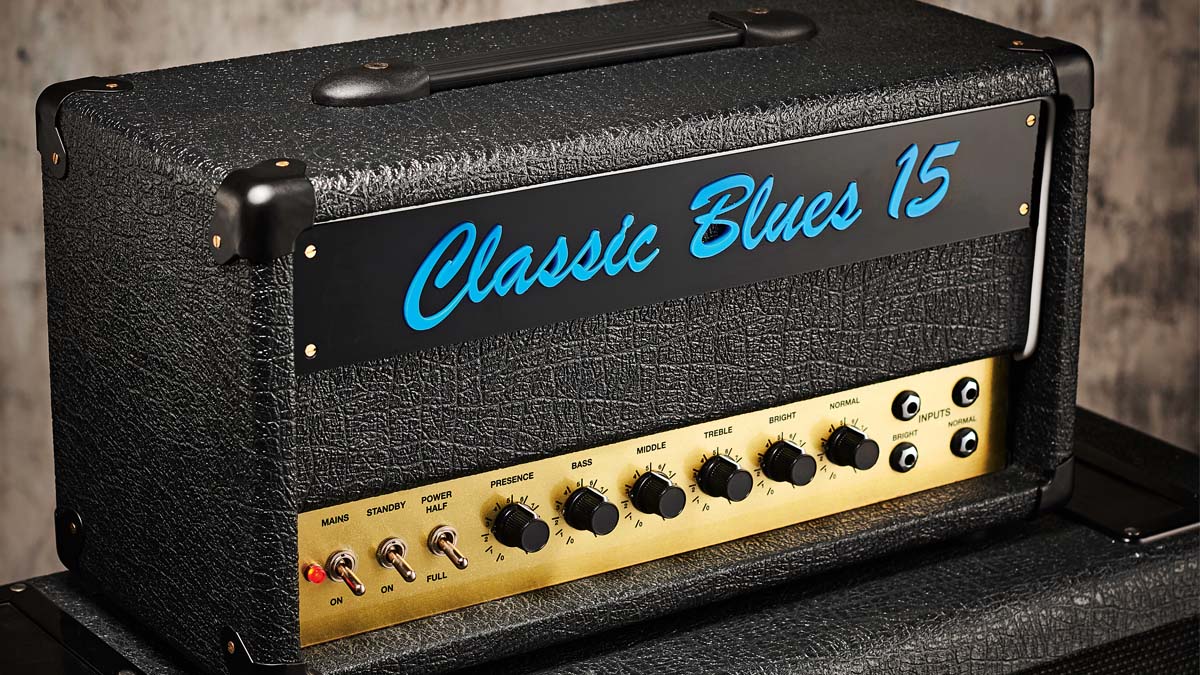Guitar World Verdict
Compact but powerful enough to light up most gigs – and definitely a great studio amplifier – the Classic Blues 15 is a meticulously constructed all-valve head.
Pros
- +
All-valve.
- +
Hand-wired.
- +
Built to last a lifetime.
- +
Great reproduction of a legendary design.
Cons
- -
At this price, there’s nothing to criticise!
You can trust Guitar World
Based in Essex, amp guru David Lane is well known for his amp repair and customising work, and for some time now he’s also been building his own range of all-valve amplification.
Last year, we looked at David’s Classic Blues 30, which is a close reproduction of the legendary Marshall JTM45, complete with a pair of KT66 output valves. As anyone who’s plugged into one will know, the JTM45 is big and loud – so this month we’ve picked out David’s latest addition, a compact lower-output alternative called the Classic Blues 15.
It keeps the same circuit and layout but swaps KT66s for a pair of 6V6s to produce around 15 watts. Like its bigger brother, the Classic Blues 15 is a traditional all-valve head that’s surrounded by a tough vinyl-clad plywood sleeve with a heavyweight perforated-steel rear-panel to protect the valves and help keep things cool.
The Classic Blues 15’s internals are meticulously assembled, with clean bright soldering and carefully routed wiring
The electronics sit in a robust steel chassis, which supports all the valve bases and a generously sized pair of mains and output transformers. Inside, the electronics sit on a heavy duty eyelet board – a thick slab of Bakelite drilled and fitted with brass eyelets into which the resistors and capacitors are soldered, with hand-wired pots and valve bases bolted to the chassis.
Eyelet boards tend to be associated more with American designs because this is how vintage Fenders were built, while many old British amps favoured turret board construction. In terms of audio fidelity and standing up to the knocks, there’s little or no difference between the two methods.
What’s more important on valve designs like this one is the parts quality and layout. Like David’s other amps, the Classic Blues 15’s internals are meticulously assembled, with clean bright soldering and carefully routed wiring.
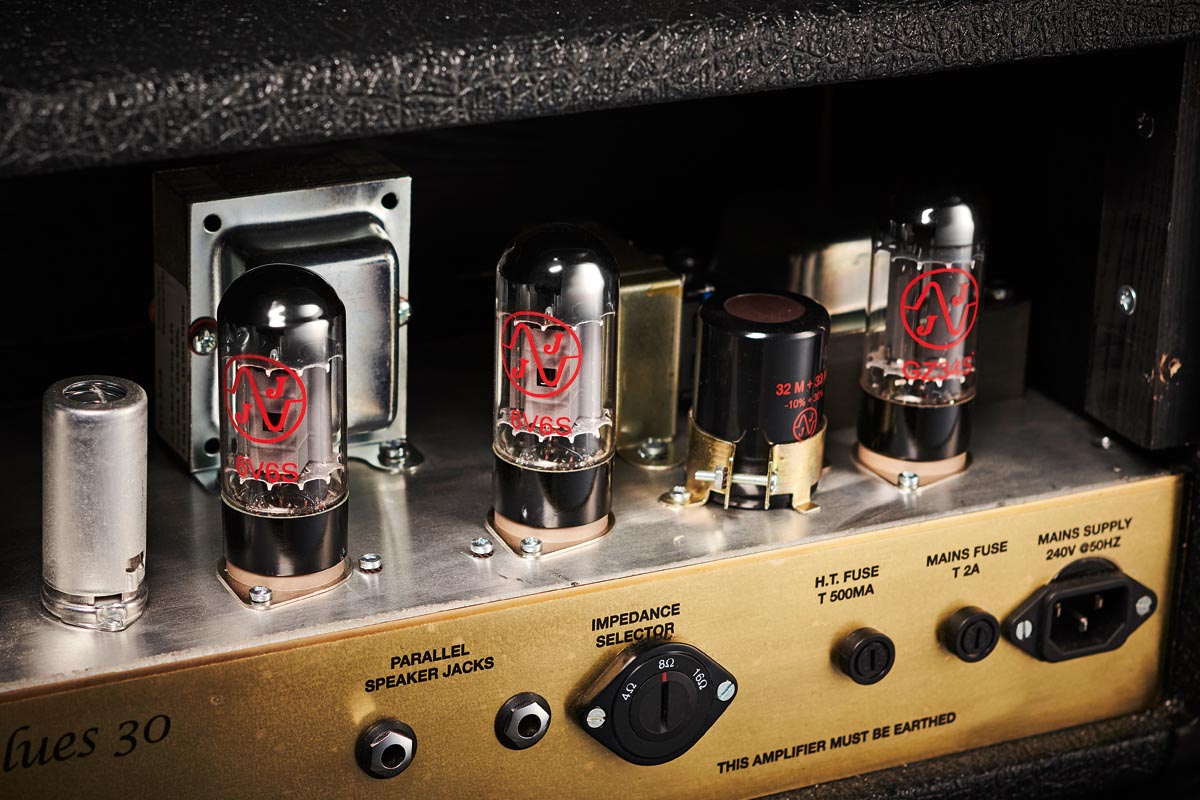
It’s clear from this build that everything’s been put together by somebody who knows a lot about old-school valve amplification: top-quality components include Alpha pots, Mallory capacitors and transformers by Transformer Equipment from Sandwich in Kent, who previously supplied Cornford amplifiers.
The circuit includes three 12AX7 twin-triode preamplifier valves, a pair of JJ 6V6S output valves and a GZ34 rectifier. Introduced in 1937, the 6V6 was a scaled-down version of RCA’s 6L6. Its small size and lower power requirements made it hugely popular in the burgeoning post-war American consumer electronics market where it was typically used in home and car radios – and, of course, guitar amplifiers.
The impressive headroom makes it a great platform for pedals, adding extra warmth and sparkle to all kinds of modulation effects
The Classic Blues 15’s JTM45-inspired front panel features Normal and Bright channels, each with a pair of high- and low-gain input jacks and separate volume controls.
There’s also a shared passive EQ with knobs for bass, mid, treble and presence, together with a useful half-power switch that reduces output down to around seven watts. Meanwhile, the minimalist rear panel features a pair of speaker jacks complete with heavy-duty tamper-proof impedance selector.
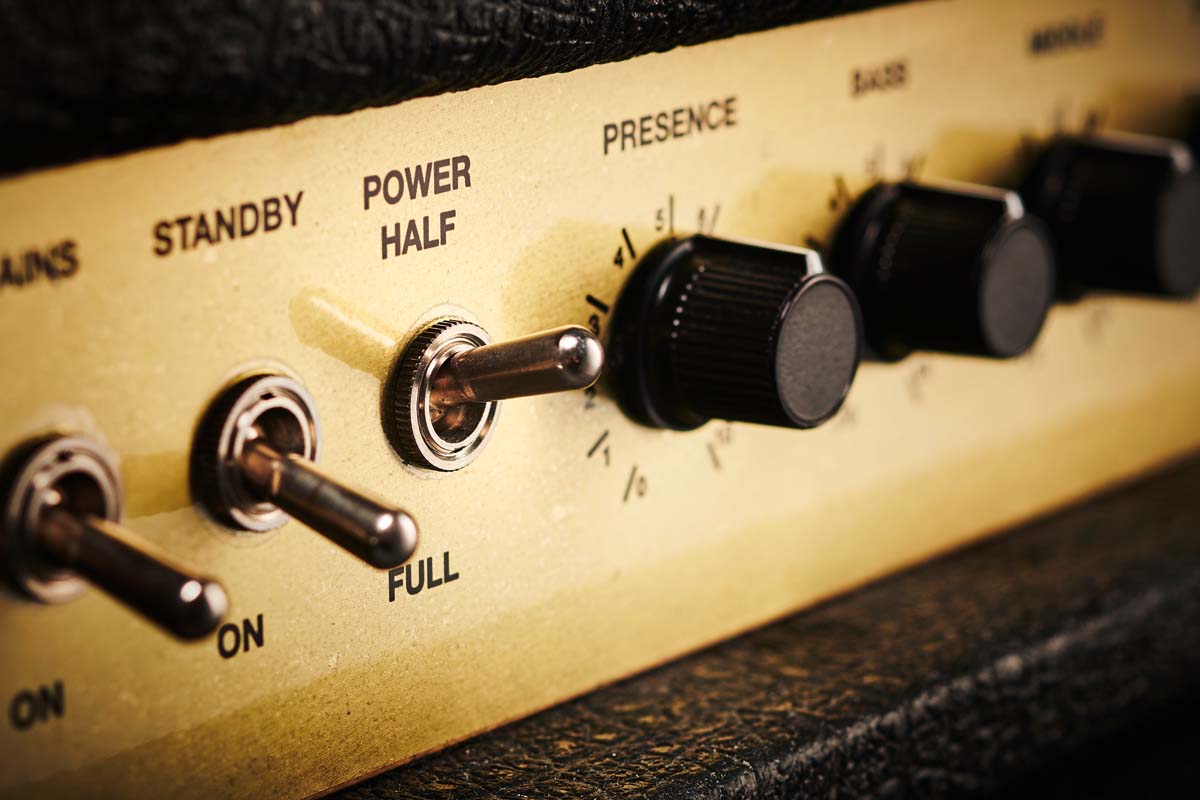
Feel & Sounds
We tried out the Classic Blues 15 with our usual selection of guitars, including a Les Paul loaded with a pair of Seymour Duncan PAFs and a Strat fitted with Seymour Duncan Alnico Pro 2 single coils.
As you’d expect from a circuit that’s closely based on the JTM45, the Bright channel has a glassy, sparkling top-end that fits best with warm humbuckers, while the Normal channel is fat and warm, ideally suited to the single-coil pickup.
Both channels run in parallel and are permanently on – there’s no means to footswitch between them but you can use a small patch lead to link the low-gain input jack on one preamp channel with the high-gain jack on the other.
Once this is plugged in, both volume controls become active, letting you mix Bright and Normal channels to taste, fine-tuning the result with the regular tone controls. You also get a little extra gain, making it easier to push the amp into overdrive.
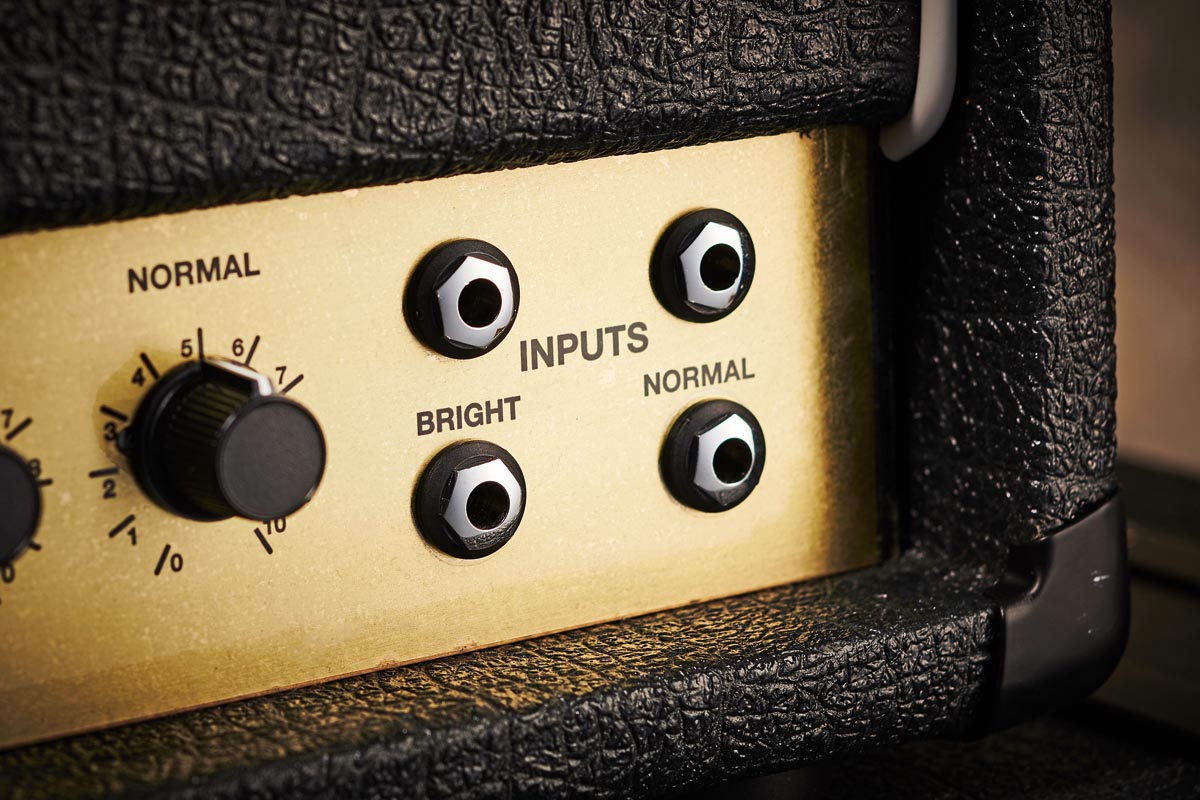
Tonally, the Classic Blues 15 does pretty much what it says on the tin: it’s perfect for British blues revival stuff, with a slightly fatter midrange than the KT66-equipped Classic Blues 30.
This buttery midrange is a characteristic of the 6V6 and helps to smooth things out for soulful, sustained leads. There’s no master volume, so to get any kind of meaningful overdrive you have to turn it up, at which point things get excitingly loud.
For more control of your lead sounds at lower volume levels, you might consider an attenuator or overdrive pedal. Meanwhile, the impressive headroom makes it a great platform for pedals, adding an extra dose of warmth and sparkle to all kinds of modulation effects.
Running in full-power mode, the Classic Blues has enough poke to handle most gigs, depending on the type of speaker cabinet you hook it up to. We used a V30-loaded 2x12 for most of our testing, together with another enclosure fitted with Jensen and Tone Tubby Alnico drivers. The Classic Blues 15 sounded equally impressive through both cabs.
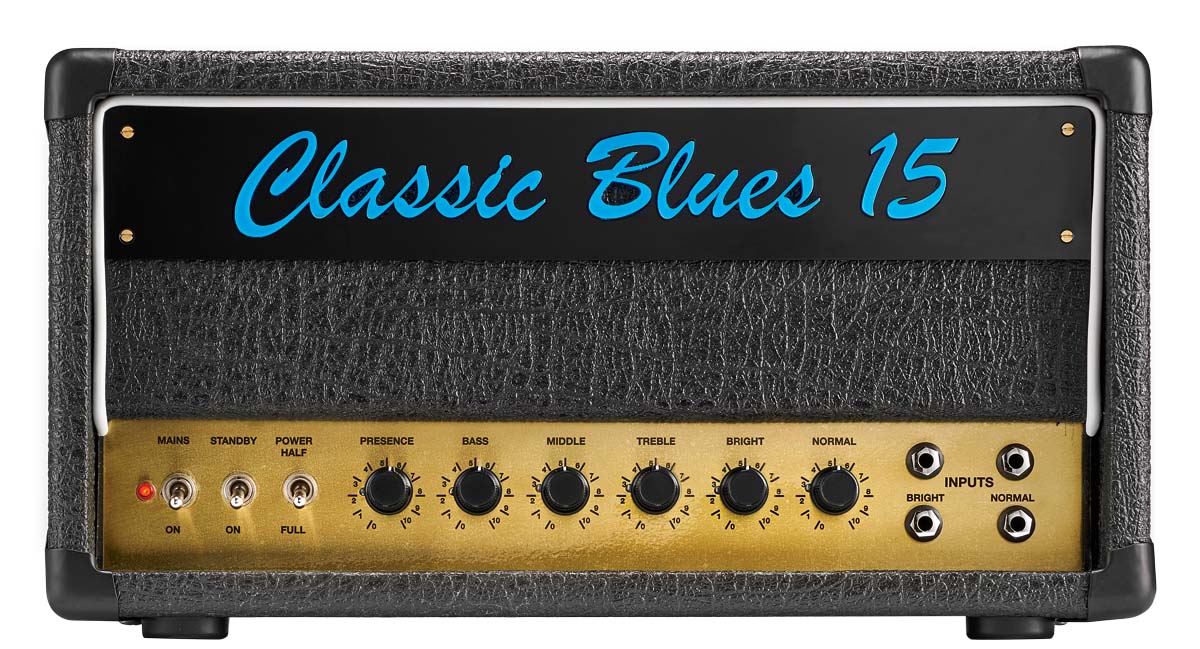
Verdict
Building a valve amp that works isn’t so difficult. However, building one that sounds and responds so well you don’t want to unplug it is another learning curve altogether. You can fill bookshelves with reference books and schematics but there’s no substitute for hands-on experience – and David Lane has spent decades working with high-voltage valve guitar amplification.
As the years draw on, books and schematics may survive but arcane valve guitar amp knowledge that was never written down is slowly being lost to time – one reason why quality hand-built amps like this are becoming increasingly difficult to find.
On a more practical level, thanks to reduced dimensions and smaller transformers, the Classic Blues 15 is compact, very easy to carry and still packs enough power for the average pub gig, while the Half Power switch tames things nicely for home and studio use. David’s Classic Blues 15 is a particular amp for a particular kind of player.
If you’re after push-button programmable convenience then it probably won’t be for you… but if you want to experience the sonic depth charge of a great pure valve circuit, it’s definitely worth checking out.
Specs
- PRICE: £950
- ORIGIN: UK
- TYPE: All-valve preamp and power amp with valve rectifier
- OUTPUT: 15W or 7W
- VALVES: 3x 12AX7, 2x 6V6S, 1x GZ34
- DIMENSIONS: 460 (w) 240 (h) x 210mm (d)
- WEIGHT (kg/lb): 10/22
- CABINET: Plywood
- CHANNELS: 2, parallel non-switching
- CONTROLS: Normal volume, Bright volume, bass, mid, treble, presence
- FOOTSWITCH: None
- ADDITIONAL FEATURES: External speaker jack, series effects loop, line out
- OPTIONS: None
- RANGE OPTIONS: The compact chassis version of the Classic Blues 30 with bigger transformers and KT66s sells for £1,150
- CONTACT: Lane UK Handmade Amplification
Nick Guppy was Guitarist magazine's amp guru for over 20 years. He built his first valve amplifier at the age of 12 and bought, sold and restored many more, with a particular interest in Vox, Selmer, Orange and tweed-era Fenders, alongside Riveras and Mark Series Boogies. When wielding a guitar instead of soldering iron, he enjoyed a diverse musical career playing all over the UK, including occasional stints with theatre groups, orchestras and big bands as well as power trios and tributes. He passed away suddenly in April 2024, leaving a legacy of amplifier wisdom behind him.
“The world’s most convenient all-tube amp head”: Steve Vai-backed firm Synergy has unveiled a tiny amp head that lets you swap in tones from some of the world’s biggest amp builders
“Modified connects us with a long-standing tradition of modifying Marshall amps that dates back to the 1970s”: Marshall unveils factory modded takes on the 1959 Plexi and JCM800 – tipping its cap to the amp wizards of rock’s golden era
